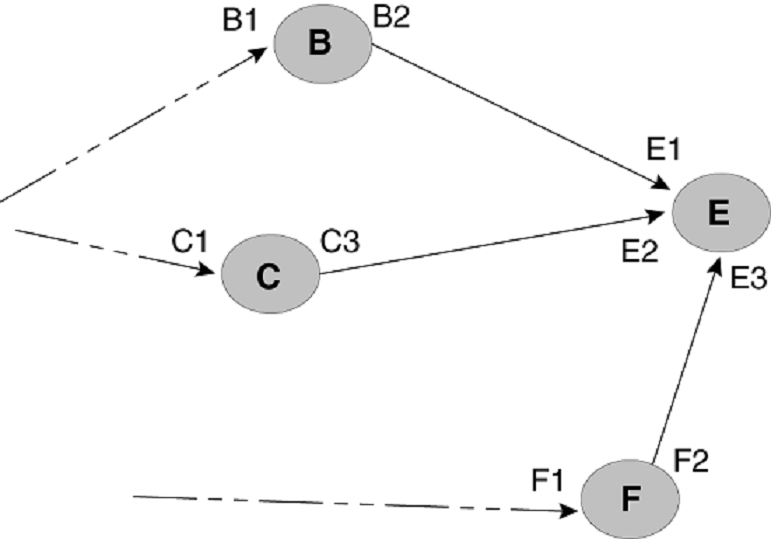Calculating a Path Based on an Interface Address
Under normal conditions, router IDs are used to configure hops within an MPLS path. In situations where the user wants to exercise more control over the path, the user can specify actual interface addresses in the MPLS path to make sure that the path traverses the interface specified. In previous versions, the CSPF calculation would always resolve a specified interface address to the router ID. Consequently, although a particular interface on a router is specified, the CSPF calculation can end up connecting the path through a different interface on the router where the interface has been specified.
In the network described in the diagram below, the source node is "A" and the destination node is "E". In this configuration, incoming and outgoing interfaces are defined in the figure by their relationship to where the arrowhead on the connecting line points. The arrowheads point to the incoming interface from the outgoing interface. For instance "A1", "A2" and "A3" are the outgoing interfaces of node A and "C1" and "C2" are the incoming interfaces of node C. The following example describes how the router might calculate a path between "A" and "B" under the default operating condition.
In this example, an MPLS path has been configured with a source "A" and a destination "E1". Under default operation, the interface "E1" destination is resolved to the routerID for "E". This means that the path can be calculated to arrive at the "E" node on any of the following interfaces: "E1, "E2" or "E3". While a path that travels from node "A" to node "B" to node "E" is the only path that actually satisfies the intent of the configuration, any of the following paths could be created by CSPF under the default operation condition: "A" to "C" to "E", "A" to "D" to "C" to "E" or "A" to "D" to "F" to "E".

The global cspf-interface-constraint command directs the router to include the interface address as a constraint when it determines the shortest path. When invoked, this command ensures that a specified interface must be included in an LSP. This constraint can be turned on and off dynamically and does not affect established primary or secondary LSPs. CSPF interface constraint is significant for the ingress node only, where CSPF calculation takes place for an LSP.
When configuring CSPF interface constraint, the user must be aware that the imposition of this additional constraint can increase the possibility of no path being found where otherwise there could be a path. One case where this can occur is where the path required to conform to the interface constraint fails the configured bandwidth constraint. Additionally, no path may be found where a configured path contains an inherently contradictory condition. For example, when a path is configured "B1 (strict) to E2 (loose) as shown in the diagram below, no path is found. This is because CSPF always appends B1 into the final CSPF path. This has the effect of making "B" the source node of the next hop and therefore excludes "E1 as a traversed interface in subsequent paths to the destination node "E". Consequently, in this example the LSP is down. However, when the cspf-interface-constraint command is not active, a CSPF path is found and the LSP goes up.


